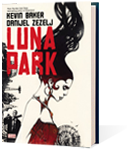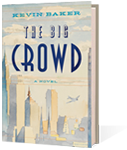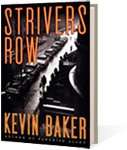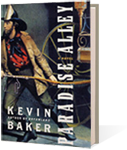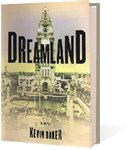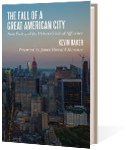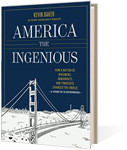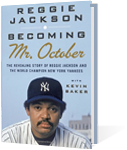By Patrick Cooke
The Wall Street Journal
Copper-riveted jeans, the first oil rig, running shoes, dry cleaning and the 23-story-high clipper ship—as American as apple pie.
Among the many rewards of America the Ingenious, Kevin Baker ’s survey of Yankee know-how, is stumbling on its buried nuggets. Here is a handful. The computer onboard Apollo 11’s lunar landing craft, Eagle, possessed less memory than today’s average cellphone. The letters in the Morse code message S.O.S. don’t mean anything; they’re just easy to send and hear. In the 1920s people spent five to six hours on weekend days at fabulously baroque movie palaces like the 3,000-seat Strand in New York City. Before 1930, most American cars were so aerodynamically ineffective that they were more efficient driven backward. Les Paul nearly died when he was electrocuted in his Queens, N.Y., apartment while perfecting the electric guitar.
Readers will unearth one or two such treasures on nearly every page as Mr. Baker examines a wide range of the achievements that have made, and still make, America great again—and again. There are 68 entries in all, most of them no longer than the length of this review. His subjects vary in scope from public-works projects like the Southern California Aqueduct to everyday items like Liquid Paper and the lowly safety pin. “The inventions in this book are inextricably linked to the American experiment,” the author writes. “They were inspired, shaped and made possible by the character of our country.”
Mr. Baker launches his tour with a look at the prairie schooner, the nearly indestructible wagon design that took some 500,000 pioneers west in the middle decades of the 19th century. About the size of a minivan, this beast weighed 1,300 pounds and could haul 3,000. At two miles per hour under ox power, it covered 15 to 20 miles a day. Its front wheels were smaller than the rear for easy tight turning—circle the wagons, boys!—and the whole thing could float if need be. Most schooner owners preferred to walk rather than ride in a rig so rough that a bucket of milk left inside in the morning was churned by nightfall.
From this departure point Mr. Baker skips hither and yon in time, breaking his subjects down into loose categories. “Apparel” includes entries on copper-riveted jeans, the first bra, running shoes and dry cleaning—a process that owed its origins to the production of poison gas during World War I. “Powering” examines, among other creations, the first oil rig and the original solar cell. “Roaming” explores the building of the Panama Canal, a dream car called the Lincoln Zephyr and the stately 23-story-high Yankee Clipper sailing ship of the mid-1800s, capable of covering close to 465 nautical miles in 24 hours.
Some readers may find a few of Mr. Baker’s selections questionable. He cites Jazz and the Blues as being just as much an American innovation as, say, the pioneer-era Pennsylvania Rifle. Fair enough, even if musical idioms feel a touch beyond his brief. A section on transportation subtitled “How Will We Travel in the Future?” seems a departure from known innovation into the Buck Rogers science-fiction fantasy of the 1940s: The levitating hover board? It doesn’t exist. Nor has the flying car given a lift to the world of aviation—though it is interesting to learn that there have been 2,400 flying-car designs, and 300 prototypes have taken flight, however briefly.
Mr. Baker is good at pointing out the unanticipated consequences that arose from some inventions: Richard Jordon Gatling, inventor of the Gatling gun, a fearsome instrument of battlefield butchery still in use in some forms today, believed that his contribution would save lives—depending on which side of the gun you were on—because one man operating the weapon would reduce the need for other soldiers. The inventor who created television, Philo Farnsworth, believed that his device could bring about world peace. “If we were able to see people in other countries and learn about our differences, why would there be any misunderstandings?” he wrote. “War would be a thing of the past.” And you wouldn’t need the Gatling gun.
Like Farnsworth, many of the inventors in “America the Ingenious” came from impoverished upbringings and had little formal education. Walter Hunt, creator of the safety pin, was educated in a one-room schoolhouse but went on to invent scores of other items, including a device that allowed circus performers to walk upside-down on ceilings. Elisha Graves Otis, of Otis elevator fame, was a high-school dropout who, according to his son, Charles, “needed no assistance, asked no advice, consulted with no one, and never made much use of pen or pencil.” Of the innovators who undertook world-changing engineering feats, it is remarkable how often they brought them in under budget and ahead of schedule, among them the Golden Gate Bridge, Hoover Dam and New York’s Hudson and East River railroad tunnels.
Mr. Baker’s book neatly follows the fluid boom to bust to boom times of the nation’s history: Telegraph begets trans-Atlantic cable. Andrew Carnegie ’s revolutionary steel-processing system makes skyscrapers possible and thus the modern city. Whale oil fuels train headlamps that show the way across the west at nighttime. Refined petroleum replaces whale oil just in time for the arrival of the automobile. Hoover Dam delivers electricity to Southern California and the Southwest, which in turn run newly invented air conditioners that make scorching deserts habitable and prompt a middle-class migration.
America itself is an ingenious idea, the author concludes, and the man who he insists most exemplifies its spirit is Alexander Hamilton, an immigrant “who grew up in wretched and sometimes horrible circumstances in the West Indies.” Hamilton would rise to become the nation’s first secretary of the Treasury. Not a particularly sexy job but a vital one. He recognized that to succeed we would “require education, capital, machines, cities, better communications [and] faster transportation.” As Mr. Baker writes: “Hamilton is great because he made America a country that could make things.”

